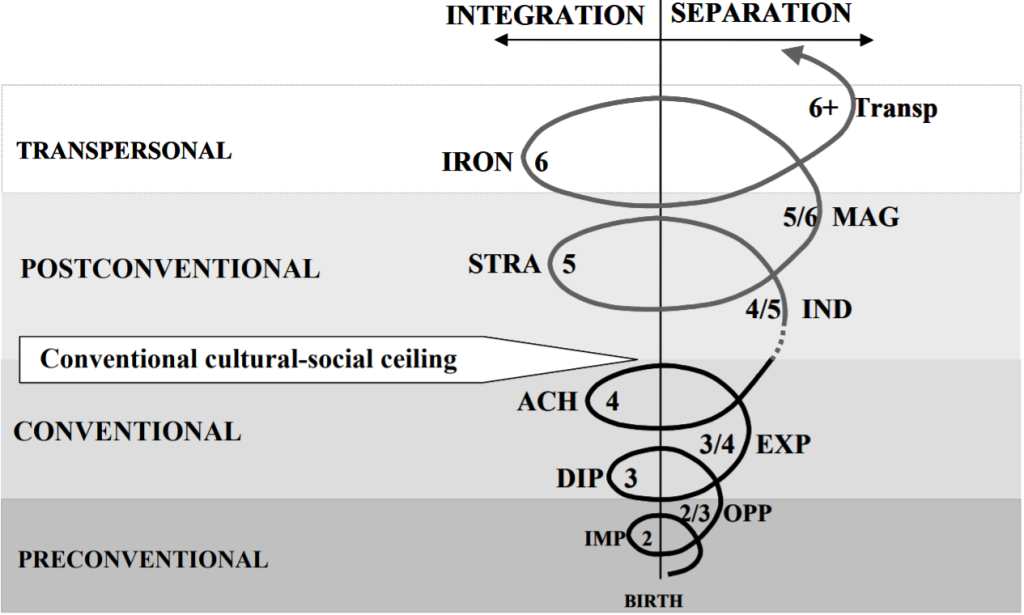Is there a difference between learning and development?
I ruminated over this question for a number of years as a Learning & Development professional, but without much progress.
I could never draw a clear line between the two, so I considered the “D” in “L&D” to be a simple tautology.
That was until a colleague of mine recommended I read Making the Case for a Developmental Perspective by Dr Suzanne R Cook-Greuter.
Bidirectional POV
Cook-Greuter distinguishes between two directions of human development: horizontal growth and vertical transformation.
Horizontal growth refers to the gaining of new knowledge, skills and behaviours within a particular stage of development. In doing so, the learner becomes better equipped to perform in their environment.
Vertical transformation is much more sophisticated. Rather than expanding capability within the same stage of development, the learner promotes their intellect to a higher stage of development.
The Leadership Development Framework (LDF) models this transformation as an upward spiral from the preconventional Impulsive and Opportunist through to the transpersonal Ironist and beyond:
Each stage of development represents a level of wisdom that transcends the one before it.
The vast majority of people in modern society (and hence in the workplace) occupy the conventional stages of Diplomat, Expert and Achiever. Promotion to the postconventional stages of Individualist, Strategist and Alchemist is relatively rare, while I presume the transpersonal stages are the realm of the Zen Master.
(For profiles of the seven most common stages in the workplace, refer to Rooke & Torbert’s Seven Transformations of Leadership.)
The sound of a penny dropping
As I read Cook-Greuter’s paper, it dawned on me that her bidirectional model of development can represent the two sides of the L&D equation:
- Horizontal growth represents the “L” – improving your competence.
- Vertical transformation represents the “D” – maturing your mind.
I think it’s fair to say most L&D professionals focus their energy in the L space:
- Classroom-based training
- Online courses
- System simulations
- Job aids
- Assessments
- Performance appraisals
- Coaching
But this might only be going half way.
Cook-Greuter maintains that to help people transform, “only specific long-term practices, self-reflection, action inquiry, and dialogue, as well as living in the company of others further along the development path has been shown to be effective” (pp. 3-4).
In other words, meaningful transformation requires deep intervention which is personally driven and fostered by peers. The role of the L&D professional is to facilitate it:
- Communities of practice
- Enterprise social networking
- Disruptive content
- Cross-departmental problems
- Mentoring
In addition, reflection and deep thinking requires time, permission and support – so we need to secure managerial buy-in.
We can’t “do” development for others; they must do it for themselves. However we can cultivate the right environment and empower them to make the most of their opportunities.
Why bother?
That’s a question that has been on my mind since I wrote Shades of green last year. Does all this warm and fuzzy stuff really make a difference to the performance of the business? I’m convinced the answer is yes.
Of course horizontal growth remains important. Every employee has a job to do, and since nobody’s perfect, there will always be opportunities to increase knowledge, expand skillsets and change behaviours to do those jobs better.
Complementing that, I see the ROI in developing people vertically. When we refine our views of the corporate system and our roles in it, we think more strategically, work more efficiently, and collaborate with one another more effectively. In short, we perform better.
So it is clear to me now that the role of the L&D professional is two-fold: by definition, it’s to help people learn and develop.


